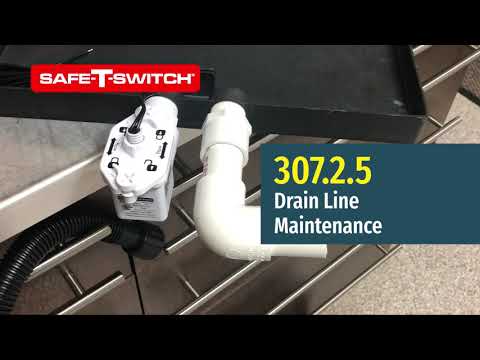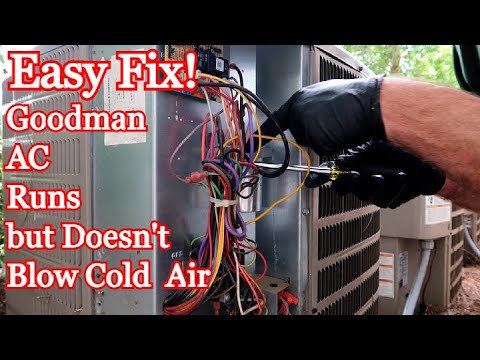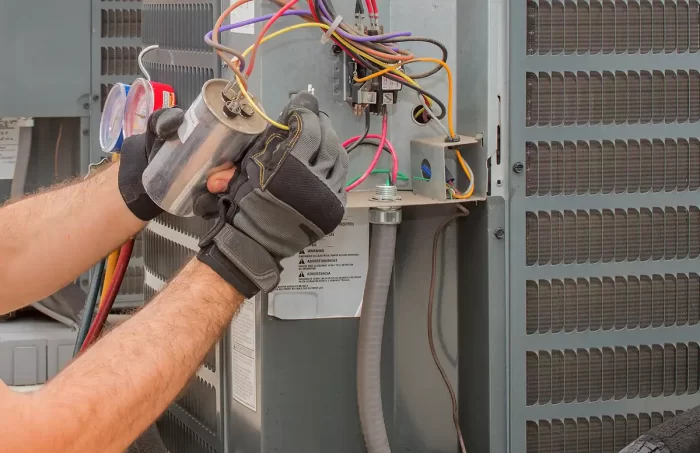Safe T Switch Ac Keeps Filling With Water: Troubleshooting Solutions
If your Safe T Switch AC keeps filling with water, it could be due to a leak or blockage in the condensate drain line. This line is responsible for carrying away moisture from the evaporator coils.
If there is a break or obstruction in the line, water can back up and fill the pan around the safety switch.
Reasons Why Safe T Switch Ac Keeps Filling With Water
One possible reason why Safe T Switch AC keeps filling with water is a potential leak or blockage in the condensate drain line. This line is designed to remove moisture from the evaporator coils, but if there is a break or obstruction, water can accumulate and fill the pan surrounding the safety switch, causing it to continuously fill with water.
:
The Safe T Switch AC can fill with water due to several reasons. Here are some potential causes to consider:
- Clogged condensate drain line:
- Accumulation of dirt, debris, and algae can block the condensate drain line.
- A clogged drain line prevents proper drainage of water, causing it to overflow and fill the Safe T Switch AC.
- Faulty condensate pump:
- The condensate pump is responsible for pumping water from the AC unit to the drain line.
- If the condensate pump malfunctions or stops working, the water will not be expelled properly, resulting in the Safe T Switch AC filling up with water.
- Malfunctioning condensate switch:
- The condensate switch is designed to detect an overflow of water in the drain pan and shut off the AC unit to prevent further damage.
- If the condensate switch is faulty or malfunctioning, it may fail to activate, allowing water to continuously fill the Safe T Switch AC.
Addressing these issues promptly can help resolve the problem of the Safe T Switch AC continuously filling with water. An HVAC professional should be contacted to assess and fix the underlying cause of the water accumulation.

Credit: www.amazon.com
Checking And Cleaning The Condensate Drain Line
A common issue with Safe T Switch AC systems filling with water may be caused by a leak or blockage in the condensate drain line. This can result in the water backing up and filling the pan around the safety switch.
:
Inspect the condensate drain line for blockages:
- Check the condensate drain line for any visible blockages or clogs. Look for debris, algae growth, or ice buildup. If you notice any obstructions, they may be preventing the water from draining properly.
Use a pipe brush or wire to clear any debris:
- If you see blockages in the condensate drain line, you can use a pipe brush or wire to clear the debris. Gently insert the brush or wire into the drain line and carefully remove any obstructions. Be cautious not to damage the line in the process.
Flush the drain line with water or a mild cleaning solution:
- To ensure the condensate drain line is clear, you can flush it with water or a mild cleaning solution. Mix a solution of equal parts water and vinegar or water and bleach. Use a funnel to pour the solution into the drain line or attach a hose to the line and flush it with the solution. This will help remove any remaining debris or buildup.
Regular maintenance is key to preventing the condensate drain line from filling with water. By inspecting, cleaning, and flushing the drain line, you can ensure that it remains clear and functions properly. If you continue to experience issues with water filling up in the Safe T Switch AC, it may be necessary to consult a professional HVAC technician for further assistance.
Testing And Replacing The Condensate Pump
If your Safe T Switch AC keeps filling with water, it could be due to a leak or blockage in the condensate drain line. This can cause water to back up and fill the pan around the safety switch. Fixing the drain line issue should solve the problem.
Is your Safe T Switch AC unit constantly filling with water? This can be a frustrating issue that needs to be addressed promptly. One possible solution is to test and replace the condensate pump. Below, we will walk you through the steps to verify if the pump is working properly, ensure it is receiving power, and replace it if necessary.
Verify If The Condensate Pump Is Working Properly:
- Check if the pump is making any noise or vibrations when the AC is running.
- Listen for any splashing sounds, which could indicate that the pump is trying to remove water.
- Inspect the pump for any signs of damage, such as leaks or cracks.
- Test the pump by pouring a small amount of water into the condensate pan and see if the pump activates to remove the water.
Ensure The Pump Is Receiving Power And The Float Switch Is Functioning:
- Locate the power supply for the condensate pump and ensure it is properly connected.
- Check if the float switch, which activates the pump when the water level rises, is functioning correctly.
- Clean any debris or obstructions that may be interfering with the float switch’s operation.
- Test the float switch by manually lifting it and observe if it triggers the pump to start.
Replace The Condensate Pump If Necessary:
- Purchase a new condensate pump that is compatible with your AC unit.
- Disconnect the power supply to the old pump and remove it from the AC system.
- Install the new pump following the manufacturer’s instructions, making sure to connect all the necessary wires and tubing.
- Test the new pump by pouring a small amount of water into the condensate pan and verifying if it activates properly to remove the water.
By following these steps, you can effectively test and replace the condensate pump in your Safe T Switch AC unit. Remember, if you are unsure about any part of the process, it is always recommended to consult a professional HVAC technician for assistance.
Verifying And Adjusting The Condensate Switch
If your Safe T Switch AC keeps filling with water, it could be due to a leak or blockage in the condensate drain line. This can cause water to back up and fill the pan around the safety switch. Identifying and fixing the issue with the condensate switch is crucial to avoid any potential damage to your AC system.
:
If you’re experiencing issues with your Safe T Switch AC filling with water, it’s important to verify and adjust the condensate switch. Follow these steps to ensure proper installation and functionality:
- Check if the condensate switch is properly installed and connected:
- Inspect the switch to ensure it is securely installed in the correct position.
- Make sure all electrical connections are tight and free from any damage.
- Verify that the switch is properly positioned in the condensate drain line to detect any overflow.
- Test the switch for functionality and make any necessary adjustments:
- Pour water into the condensate drain line to simulate an overflow.
- Observe if the switch activates and shuts off the AC system.
- If the switch fails to function, try adjusting its position to increase sensitivity.
- Test the switch again to ensure it activates and stops the AC system when needed.
- If the switch is defective, replace it with a new one:
- Consult the manufacturer’s instructions for the correct replacement switch.
- Follow the installation steps provided to ensure proper functionality.
- Test the new switch to verify its effectiveness in preventing water overflows.
Remember, the condensate switch plays a crucial role in preventing water damage caused by AC system overflows. Regularly inspecting and maintaining this switch can help keep your system running smoothly and avoid potential issues.
Cleaning The Ac Unit And Performing Regular Maintenance
A common reason for the Safe T Switch AC to keep filling with water is a potential leak in the condensate drain line. This line is responsible for removing moisture that accumulates on the evaporator coils. If there is a blockage or breakage in the line, water can accumulate and fill the pan around the safety switch.
Regular maintenance and cleaning of the AC unit can prevent this issue.
:
Regular maintenance is crucial for ensuring the optimal performance of your AC unit and preventing issues such as the Safe T Switch AC filling with water. By following these steps, you can keep your AC unit clean and minimize the risk of blockages:
- Clean the evaporator coils and fins to prevent blockages: The evaporator coils and fins can accumulate dirt and debris over time, leading to blockages. To clean them, follow these steps:
- Turn off the power to the AC unit.
- Remove the access panel to gain access to the coils and fins.
- Use a soft brush or vacuum cleaner to gently remove any dirt or debris from the coils and fins.
- Alternatively, you can use a coil cleaner specifically designed for AC units.
- Be careful not to bend the fins while cleaning them.
- Remove any accumulated dirt or debris from the AC unit: In addition to cleaning the evaporator coils and fins, it’s important to remove any dirt or debris that may have accumulated in other parts of the AC unit. Here’s how:
- Check the condensate drain line for any clogs and clear them if necessary.
- Clean or replace the air filter regularly to maintain proper airflow.
- Inspect the condensate pan and remove any standing water or debris.
- Ensure that the drain line is properly connected and free from obstructions.
- Schedule regular maintenance checks to ensure optimal performance: Regular maintenance checks by a professional HVAC technician can help identify potential issues before they escalate. Consider the following:
- Schedule annual maintenance visits to inspect and service your AC unit.
- During these visits, the technician will clean and inspect various components, including the Safe T Switch.
- They can also check for any leaks or other issues that may contribute to the AC unit filling with water.
- Regular maintenance can extend the lifespan of your AC unit and improve its energy efficiency.
By regularly cleaning your AC unit and scheduling maintenance checks, you can prevent blockages and ensure that your Safe T Switch AC does not fill with water. Keep in mind that if you encounter any persistent issues, it’s best to consult a professional HVAC technician for further assistance.
Considering Professional Assistance
Safe T Switch AC keeps filling with water due to a potential leak in the condensate drain line. This can cause water to back up and fill the pan around the safety switch. Professional assistance can help identify and fix the issue to ensure proper functioning of your AC system.
:
If troubleshooting steps do not resolve the issue, it may be time to seek help from a professional HVAC technician. They have the expertise to diagnose the problem accurately and provide appropriate solutions. Here are some reasons why you should consider professional assistance:
- Accurate diagnosis: An HVAC technician can thoroughly inspect your Safe T switch AC and identify the root cause of the water filling issue. They have the necessary knowledge and experience to troubleshoot and pinpoint the problem accurately.
- Expert solutions: Once the problem is diagnosed, the HVAC technician can provide you with the most appropriate solutions to fix it. They have access to specialized tools and equipment to carry out the necessary repairs or replacements effectively.
- Peace of mind: By relying on a professional, you can have peace of mind knowing that the issue will be resolved correctly. HVAC technicians are trained professionals who follow industry standards and guidelines to ensure the safety and efficiency of your AC unit.
- Preventing further damage: Ignoring or temporarily fixing the water filling issue in your Safe T switch AC can lead to more significant problems. By seeking professional assistance, you can prevent further damage to your AC unit and potentially save yourself from costly repairs down the line.
- Saving time and effort: Instead of spending time researching and attempting various DIY troubleshooting methods, seeking help from a professional HVAC technician can save you valuable time and effort. They can quickly assess and address the issue, getting your AC back up and running efficiently.
Remember, when it comes to complex HVAC issues like a Safe T switch AC continuously filling with water, it’s best to leave it to the experts. Contact a professional HVAC technician to ensure your AC is fixed properly and to avoid any further complications.
Frequently Asked Questions For Safe T Switch Ac Keeps Filling With Water
Why Does Ac Safety Switch Keep Filling With Water?
If your AC safety switch keeps filling with water, it could be due to a leak or blockage in the condensate drain line. This causes water to back up and fill the pan around the safety switch.
How Do You Unclog A Safe T Switch?
To unclog a Safe T switch, check the condensate drain line for leaks or blockages. Clear any obstructions to prevent water from backing up.
Is A Float Switch Supposed To Have Water In It?
A float switch is not supposed to have water inside it. It is designed to monitor the water level in the condensate drain pan.
Why Does My Ac Keep Producing Water?
Your AC keeps producing water due to moisture condensation along the evaporator coil.
Conclusion
He evaporator coils, which is a natural byproduct of the cooling process. However, if your Safe T Switch AC keeps filling with water, there could be a problem. One possible reason is a leak in the condensate drain line. This line is responsible for carrying away the excess moisture, but if it’s damaged or blocked, the water can back up and fill the pan around the safety switch.
To fix this issue, you can try unclogging the condensate drain line. Another option is to inspect the float switch. It should not have water inside it, but it’s designed to monitor the water level in the condensate drain pan.
If the float switch is malfunctioning, it could lead to water filling up in the AC unit. If your Safe T Switch AC keeps filling with water, it’s important to address the issue promptly. Check for any leaks or blockages in the condensate drain line, and ensure the float switch is functioning properly.
By resolving these problems, you can prevent further water accumulation and ensure the effective operation of your AC unit.







